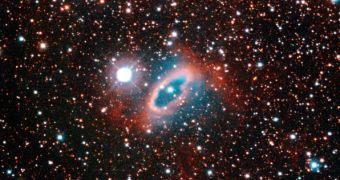SuWt 2 is a planetary nebula located in the Centaurus constellation about 6,500 light years away from Earth. It appears as a bright ring of gas with faint lobes perpendicular to the ring, thus giving it the rough look of an hourglass shape. The gas remnant is probably material ejected from a dead star which collapsed to form a white dwarf. However, investigations with NASA's International Ultraviolet Explorer satellite during the 1990s detected no such stellar object.
However, what they did find in the center of the nebula, where the white dwarf was expected to be, were two stars orbiting around each other once every five days, both hotter than the Sun but not hot enough to produce a stream of ultraviolet radiation similar to that of a white dwarf, in order to make the ring of gas glow. Further observations of the two stars, carried out by Katrina Extre and Howard Bond from the Space Telescope Science Institute, revealed that they were evolving towards a red giant phase and were both rotating slower than expected, instead of always facing the same sides.
Astronomers believe that the fact that the white dwarf star of the system is missing and that the two main sequence stars present some strange particularities could be explained through an original triple system of stars, in which two of them were orbiting close to each other while the third one, more massive, circled the two from a distance.
This particular scenario would have allowed the massive star to evolve into a red giant faster than the other two, trapping them in the so-called 'common envelope'. As the binary system draws nearer and nearer to the central core of the red giant, the envelope started to pick up speed, rotating ever faster, until the outer layers escaped into the plane of orbit to form the nebula we see today.
The ultraviolet radiation that caused the remnant to glow would have most likely been created by the hot core of the red giant, which, had it had a mass high enough, it would have turned into a white dwarf that would have cooled rapidly, thus rendering it invisible.

 14 DAY TRIAL //
14 DAY TRIAL //